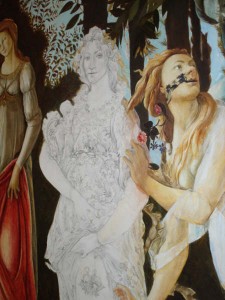New Canadians come to Canada with a myriad of different talents, experiences and backgrounds. Bujar Asllani, who has been living in Canada for nine years now, is no different. Hired as a maintenance worker six months ago at the Columbus Centre on Lawrence Avenue in Toronto, it must have come as a pleasant surprise when people at the Centre found out that Bujar was a Master Mural Artist.

I talked to Bujar as he was putting some finishing touches on a magnificent mural that he was completing in the public walkway that leads to the Columbus Centre pool.
“At first they did not know that I was artist. Later, I told them and they asked me if I was able to paint a mural. I told them that I studied and taught mural painting back home in Albania. I was an art teacher in the Academy Of Fine Arts there. At the same time I was the chief of the mural painting department. I have taught drawing, painting, monumental painting and painting technique.”
“I also have a small business working in Toronto as a mural painter. I can do murals in peoples homes, businesses, anywhere! I have worked continuously at my art, but I especially love mural painting.
I asked Bujar if he worked on canvas as well?
“Yes I do, I also do Monotype printing. This is a technique where you apply the painting to a piece of glass and press a paper over it to make a print. It’s called monotype because there is only one image made from the painting. It’s not easy because you have to paint in a concentrated way and work very quickly to get the print.”
So, this mural you are in the process of completing here at the Columbus Centre is incredible, how do you do it? Do you make a graph of the original? Or do you just copy it by eye?
“I think to make a copy of a masterpiece, sometimes it’s easy, but it could prove to be difficult. It’s very difficult for an artist that has a big vision because he needs to understand the technique of the master painters.”
“I work at everything by hand because this image is very big and projecting it on the wall can cause the image to become distorted. When drawing the details in pencil you begin to understand the direction of the master painters. You can emulate his brush stroke, application and process. When you are copying a master work you need to concentrate and discover the secrets of its creation.”
“I wrote a book back home in Albania about the techniques and the processes of the Master artists. This is something that intrigues me. It’s not just a simple reproduction. It’s like a communication with the Master and his dreams. You are reproducing his technique, but also your own process and feelings are involved as well.”
” I consider this the same as in music. A composer will have a partnership with the musician, and each musician will interpret the music differently. Therefore, his own interpretation of the piece will be different from the original. It becomes an amalgamation of the two pieces.”

“As an artist you always put some of your own psychology into the work. The piece I am working on now, I feel something different about it than I have in the past.”
The piece is called The Primavera (spring in Italian). Originally painted in the 1490s by Botticelli. It is tempera paint on wood and is 203 x 314. It now resides in the Uffizi Gallery in Florence. The mural at the Columbus Centre by Bujar is double the size of the original piece of art.
Bujar says, “I feel this painting is special. Even the people who don’t understand the process and the art, to them it’s still lovely. It’s about perfection and harmony, and the subject is the dedication of human love. It’s interpreted from the artist in a very sensitive way and I believe everyone takes something from this image and discovers something special in it.”
“I have reproduced many different Master’s works in my life but this is special for me because everyday when I come to work I find something new about this artwork. It is like a source that never finishes. It’s very interesting when I talk to my colleagues and my artist friends. We all agree that this artwork, even though it was produced five centuries ago, still has relevance today. There is something communicated through their faces. There is a total harmony to every part of the composition that makes you forget this is art.”
How did you end up in Canada of all places?
We applied for citizenship when things became unstable in Albania after the collapse of communism. There was the war in Kosovo on the boundary of Albania. The war between Serbia and Kosovo was especially bad for children. My young son needed to go to school and study, so we made this decision simply because of the children. At the same time, my older son was an exchange student in the U.S. When we came here he joined us and we are all together here now.
To contact Bujar Asllani you can find him at:


the article by alison brown was very interesting…i liked it because it revealed a man from a war torn part of the world who you wouldn’t know by looking at him that such artistic beauty can develop and cultivate while existing in a disaster zone